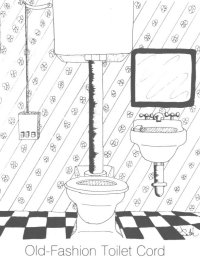|
A Brief History of the Personal Computer Trackball* Popular PC writings have it that a trackball is nothing more than "an upside down" mouse.� This is, however, quite inaccurate revisionist history and, if anything, a mouse is an upside down trackball since development of the trackball pre-dates early development of the mouse by about 11 years.� The history of both pointing devices intertwines with the development of the modern graphical user interfaces (GUI) now standard on virtually all computers. Early Beginnings
Industrial and Military Controller During the 1960's and 1970's trackballs continued to evolve as rugged, high cost, high precision input devices for industrial process control and military radar fire control systems.� Using balls from 2"-4" in diameter, these industrial trackballs from companies like Litton, Honeywell and Measurement Systems were OEM devices designed to be mounted directly into work station desk surfaces or set on the work surface in rudimentary box enclosures. The 4" trackball in the arcade game, "Missile Command", introduced by Atari in 1980 and the 2-1/4" trackball in the 1981 arcade game, "Centipede", also from Atari, are typical of the open frame panel mounted trackballs of the time.� Mice of the day were similarly regarded as exotic and specialized input devices requiring custom hardware and software for integration into an application system; the notion of using a mouse or a trackball as a stand alone peripheral device that just plugged into a host computer via a standardized hardware interface and using standardized software was non-existent. � However, the input device world was about to change. Graphical User Interfaces Arrive Both trackballs and mice were fairly obscure specialty input devices in the late 1970's and early 1980's;�the text based systems of the time (including early personal computers) all needed keyboards but they had no need for pointing devices.� But, behind the scenes, a quiet revolution in user interfaces was brewing at the Xerox Palo Alto Research Center (PARC). There at PARC the Alto I, Alto II and Star computers introduced the "graphical user interface" (GUI), a new user paradigm that combined Englebart's research on human computer interaction, English's improved ball mouse, and graphical - as opposed to text based - display hardware to form a software environment which required both a keyboard and a pointing device for effective use.� While these Xerox systems and their early GUIs are historical footnotes of technical interest but little commercial success, their influence on Microsoft and Apple, the emerging twin giants of personal computing changed the face of computing forever and, input device wise, mice were destined to become the big winners! Apple
took its first run at a GUI based computer in 1983 with the Lisa, a desktop workstation with an integrated mouse
and GUI application software suite. That same year Microsoft introduced its first
mouse (actually bundled with the Microsoft Word word processor) Mice Roll Out The driving impulse of the widespread switch from text to GUI based user interfaces led to an explosion in mouse manufacturing.� Apple was now shipping a mouse with every Macintosh computer and names now familiar in the PC mouse business like Microsoft,� Logitech and Mouse Systems began producing ever higher quantities of retail aftermarket mice in a variety of designs to capitalize on the growing acceptance of Microsoft Windows.� As with any new technology, there were endless debates about how many buttons were optimum, what was the best encoder technology, who had the mouse with the best ergonomic shape, optimum cord length etc., many of which assumed religious issue intensity.� In addition, there were significant technology issues involved in developing the software protocols, drivers and hardware interfaces required to seamlessly integrate the pointing device into the universe of software applications as they made the painful transition from text based to graphical user interface.
Trackballs Struggle to Keep Up With The Rodents
Technical merit is great but in consumer markets, marketing muscle counts for more. (Remember the videotape format war between Betamax and VHS?) Unforunately, trackballs did not have anybody with anything like the marketing muscle of Microsoft or Apple to drive them into the market place. While every computer soon arrived including a mouse as standard, there was no such OEM volume/cost driver for trackballs. As a result, early PC and Macintosh trackballs were all aftermarket products manufactured in much lower volume and as a result much more expensive than mice - a situation which persists to this day. Early PC trackballs, particularly in the Windows markets, were also handicapped by the lack of early standards for mouse drivers, display attributes and hardware interfaces which often resulted in frustrating software compatibility issues.� By the late 80's there were a only a handful of trackballs like the MicroSpeed FastTRAP, the Kensington Turbo Mouse and the Honeywell Lynx available for use on PCs and Macintoshes and their shipment volume was miniscule compared to the volume of mice being shipped. Trackballs Finally Emerge As A Mouse Alternative By the late 80's/early 90's the mouse market was fairly well saturated with products and it had become highly price competitive; mouse manufacturers began to look for other input devices to extend their product lines and improve their profit margins. Market research at the time showed that 8-10% of PC users (by then already a multi-million user installed base) would consider a trackball as an alternative to a mouse so Logitech introduced its first trackball, the original Trackman, in 1989. Plus, it was quickly pretty obvious that mice were not practical for use with portable computers and with that market starting to explode, small trackballs built into the laptop keyboard or attached to the laptop frame by a bracket also began to get some attention. Microsoft introduced their BallPoint trackball and Logitech introduced their Trackman Portable for portable computers practically simultaneously in 1991. Along in this same time period other good quality PC and portable computer trackballs from niche manufacturers began to make some inroads into the input device retail after market; these included the Kensington Expert Mouse, the MicroSpeed PC-TRAC, the ITAC MouseTRAC, among others.� The trend toward increasing acceptance of the trackball as a "nichey" mouse alternative continued and by the end of the 90's most mass market computer superstores were carrying at least 3-4 trackball models along with a selection of 15-20 mice models in the input device section. The standardization of electronic interfaces such as the Apple ADB, IBM PS/2 and USB on virtually all desktop and laptop computers plus improved optical tracking technology eliminated most remaining performance and compatibility issues, making it possible to make trackballs that were truly "plug and play" interchangeable with mice.� The trend toward input diversity peaked in the early 00's with the availability of really excellent trackballs such as the Microsoft Trackball Explorer, the Kensington Orbit, the Logitech Marble and Trackman and others. Unfortunately for the trackball, distribution channel pressures more than technology were about to intrude into what was becoming a pretty nice market niche.� By 2003, the relentless competitive pressure on "brick and mortar" store reseller profit margins from Internet stores and channel saturation combined with the now relatively low and still declining prices of replacement mice caused most resellers to begin cutting back on the amount of shelf space devoted to input devices in general in favor of products with higher prices and better profit margins.� This trend has continued relentlessly until now many retail computer stores stock only a few replacement mice and many don't carry even a single trackball. With distribution channel opportunities limited, many input device manufacturers have cut back on their trackball product lines and some, like Microsoft, have dropped them completely. Even mail order and Internet retailers seldom stock more than a handful of trackballs. But user pointing device preferences are driven by many things such as hand size, hand/eye coordination, workspace, etc. - ergonomic factors that don't change as fast as CPU technology and distribution channel whims. Trackballs remains a viable or even superior mouse alternative in many applications and they will continue to be the favorite input device of some percentage of computer users - if they can ever find them! Hence, TrackballWorld! Our selection of trackball based products is among the largest (if not THE largest) and it is growing larger every month. If you're looking for a trackball based product, we've probably got one that will meet your requirements and if not, give us a call and we'll do our best to find it for you. We've even got some suggestions on things you can do with your used mouse:
*Portions Copyright � 2007, Timothy C. Barry. All Rights Reserved. Used by permission. |
Additional resources
- Non Gamstop Casinos
- Non Gamstop Casinos
- Migliori Casino Non Aams
- Siti Casino Non Aams
- Non Gamstop Casinos
- Non Gamstop Casinos
- Non Gamstop Casino
- UK Casinos Not On Gamstop
- UK Casinos Not On Gamstop
- Casino Online Stranieri Non Aams
- Online Casinos
- Meilleur Casino En Ligne
- Non Gamstop Casinos UK
- Non Gamstop Casino Sites UK
- Casino Non Aams
- Non Aams Casino
- Casino Sites UK
- Casinos Not On Gamstop
- Meilleur Casino En Ligne
- Casino Zonder Cruks
- UK Online Casinos Not On Gamstop
- Non Gamstop Casino
- Betting Sites UK
- Non Gamstop Casinos
- Bitcoin Casinos
- Migliori Casino Online
- Nouveau Casino En Ligne Belgie
- Site De Paris Sportif Ufc
- KYC 미인증 카지노
- рейтинг казино з хорошою віддачею
- Meilleur Casino En Ligne France
- Meilleurs Casino En Ligne
- Meilleur Casino En Ligne Fran�ais
- Casino En Ligne Retrait Imm�diat 2026
- Nouveaux Casinos En Ligne
| For questions or to place an order call: 1.888.593.0488 |
Copyright � 2011 R & J Unique Products. All Rights Reserved
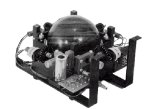 The trackball was actually invented circa
1949 by Tom Cranston and Fred Longstaff, two Canadian engineers who were working to
develop a better way to coordinate target data displayed on a then state of the art radar
system CRT display they were developing.� Called "DATAR", the original
trackball used a 4" Canadian duck pin bowling ball and weighed several pounds.�
The DATAR project was eventually cancelled but the idea of using the trackball to position
a cursor and select items on a computer display screen using X-Y axis orthogonal outputs
survived and trackballs ultimately ended up being incorporated into radar tracking and
fire control systems by a number of defense contractors worldwide.
The trackball was actually invented circa
1949 by Tom Cranston and Fred Longstaff, two Canadian engineers who were working to
develop a better way to coordinate target data displayed on a then state of the art radar
system CRT display they were developing.� Called "DATAR", the original
trackball used a 4" Canadian duck pin bowling ball and weighed several pounds.�
The DATAR project was eventually cancelled but the idea of using the trackball to position
a cursor and select items on a computer display screen using X-Y axis orthogonal outputs
survived and trackballs ultimately ended up being incorporated into radar tracking and
fire control systems by a number of defense contractors worldwide.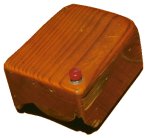 Thus the trackball was already a fairly mature military/industrial special purpose input device in the late
50's/early 60's when Doug Englebart began his groundbreaking work at SRI (Stanford
Research Institute) on human-computer user interfaces and his mouse. � Also, far from being an upside down trackball, the mouse upon which Englebart was finally
granted his original patent in 1970 - the patent was issued long after his original 1963 development work - was carved from a wood block and used orthogonal direct drive wheels for the X and Y axis, not the now familiar caged ball or optical sensors (the "ball mouse" was invented by Bill English, another SRI alumnus, in 1972). Arguments over the superiority of orthogonal direct drive mice compared to ball mice and optical mice remains a persistent mouse heresy to this day.
Thus the trackball was already a fairly mature military/industrial special purpose input device in the late
50's/early 60's when Doug Englebart began his groundbreaking work at SRI (Stanford
Research Institute) on human-computer user interfaces and his mouse. � Also, far from being an upside down trackball, the mouse upon which Englebart was finally
granted his original patent in 1970 - the patent was issued long after his original 1963 development work - was carved from a wood block and used orthogonal direct drive wheels for the X and Y axis, not the now familiar caged ball or optical sensors (the "ball mouse" was invented by Bill English, another SRI alumnus, in 1972). Arguments over the superiority of orthogonal direct drive mice compared to ball mice and optical mice remains a persistent mouse heresy to this day. 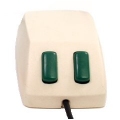 .�
While neither the Lisa nor the first Microsoft mouse achieved great commercial success, both companies persevered and Apple's introduction of the Macintosh in 1984 and the introduction of Windows by Microsoft in 1985 catapulted pointing devices from obscure special purpose input device to computer mass market necessity because it was simply not possible to effectively use a GUI based computer system without a pointing device.� Thus, there was instantly created a market for a pointing device to be shipped with each new GUI equipped computer system plus an after market for millions more pointing devices for existing systems being upgraded to use the new GUI software. � And, since both Apple and Microsoft followed Xerox's lead by using the mouse as their pointing device of choice, mice really hit the big time.� Had the roles been reversed with the trackball as the pointing device of choice for use with these early GUI systems, the odds are good that today the trackball would be the familiar mass market product and the mouse the obscure option.
.�
While neither the Lisa nor the first Microsoft mouse achieved great commercial success, both companies persevered and Apple's introduction of the Macintosh in 1984 and the introduction of Windows by Microsoft in 1985 catapulted pointing devices from obscure special purpose input device to computer mass market necessity because it was simply not possible to effectively use a GUI based computer system without a pointing device.� Thus, there was instantly created a market for a pointing device to be shipped with each new GUI equipped computer system plus an after market for millions more pointing devices for existing systems being upgraded to use the new GUI software. � And, since both Apple and Microsoft followed Xerox's lead by using the mouse as their pointing device of choice, mice really hit the big time.� Had the roles been reversed with the trackball as the pointing device of choice for use with these early GUI systems, the odds are good that today the trackball would be the familiar mass market product and the mouse the obscure option.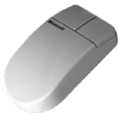 Like any manufactured product subject to the immutable laws of high volume manufacturing, mice were refined and manufacturing costs reduced in a steeply declining classic Boston Consulting Group experience curve. A mouse for the early Xerox workstations circa 1975 cost around about $400.00. By 1986 a Microsoft or Logitech PC mouse for Windows 1.0 had a retail street price of around $89. By the time Windows 3.1 launched in 1992 these "name brand" mice were down under $50. By the launch of Windows 95 in 1995 generic mice were selling for under $10.00. After the production of hundreds of millions of units plastic OEM mice can be now be had for under $1.00 each.
Like any manufactured product subject to the immutable laws of high volume manufacturing, mice were refined and manufacturing costs reduced in a steeply declining classic Boston Consulting Group experience curve. A mouse for the early Xerox workstations circa 1975 cost around about $400.00. By 1986 a Microsoft or Logitech PC mouse for Windows 1.0 had a retail street price of around $89. By the time Windows 3.1 launched in 1992 these "name brand" mice were down under $50. By the launch of Windows 95 in 1995 generic mice were selling for under $10.00. After the production of hundreds of millions of units plastic OEM mice can be now be had for under $1.00 each.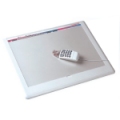 Contrary to popular opinion, mice were never regarded as the best possible input device for use with graphical user interfaces. The ground breaking ergonomics research in the original "Handbook of Human Computer Interaction", first published in 1986 by Elsevier Press, rated six graphical input devices (mouse, trackball, joystick, graphics tablet, light pen, and touch
screen) according to their effectiveness as tested in a variety of user input pointing tasks with graphical user
interfaces. In overall ratings the graphics tablet ranked first and the trackball ranked a close second; mice finished third. (Joysticks, lightpens and touch screens were judged to be specialized input devices effective for specific classes of pointing applications but not good selections for use as general purpose computer system pointing devices.)
Contrary to popular opinion, mice were never regarded as the best possible input device for use with graphical user interfaces. The ground breaking ergonomics research in the original "Handbook of Human Computer Interaction", first published in 1986 by Elsevier Press, rated six graphical input devices (mouse, trackball, joystick, graphics tablet, light pen, and touch
screen) according to their effectiveness as tested in a variety of user input pointing tasks with graphical user
interfaces. In overall ratings the graphics tablet ranked first and the trackball ranked a close second; mice finished third. (Joysticks, lightpens and touch screens were judged to be specialized input devices effective for specific classes of pointing applications but not good selections for use as general purpose computer system pointing devices.)